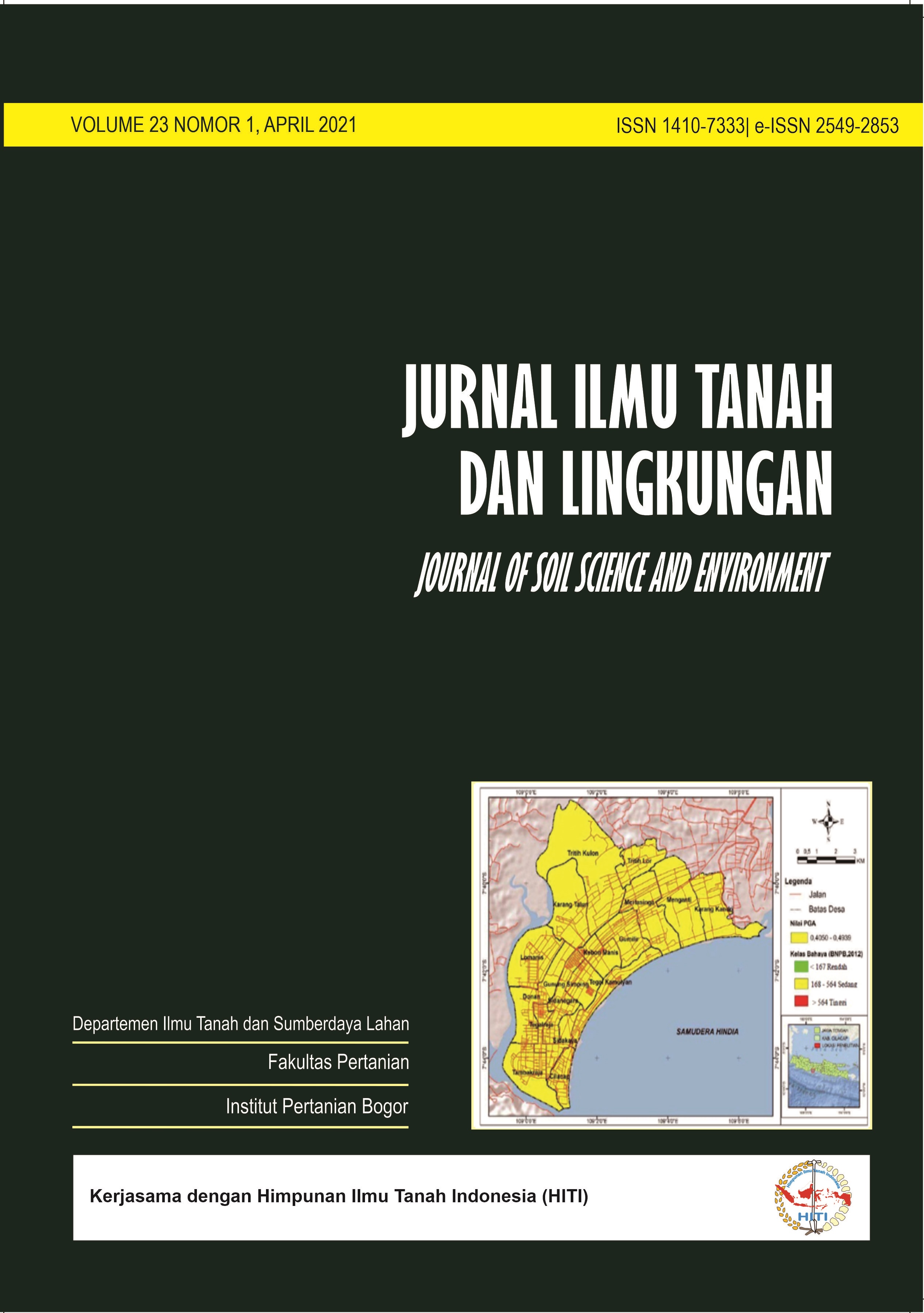Studi Literatur: Uji Kemampuan Konsorsium Isolat Bakteri Selulolitik dalam Mempercepat Dekomposisi Tandan Kosong Kelapa Sawit
Literature Study: Ability Test Of The Consortium of Cellulolitic Bacterial Isolates in Accelerating The Decomposition of Empty Palm Oil Signs
Abstrak
Salah satu cara alternatif dalam mengelola TKKS adalah pengomposan, disamping dapat mengurangi volume limbah, pengomposan dapat meningkatkan nilai nutrisi dari TKKS. Ada beberapa cara untuk mempercepat proses pengomposan. Perlakuan secara biologi dengan cara menumbuh kembangkan mikrob yang teruji (berkemampuan tinggi dalam merombak bahan) yang dikomposkan. Bakteri merupakan kelompok yang paling dominan di dalam tanah. Ukurannya yang kecil, prokariotik dan bersel tunggal memberikan keuntungan dalam perombakan bahan organik dibandingkan kelompok jamur dan aktinomisetes. Mikrob yang mampu menghidrolisis selulosa dinamakan mikroorganisme selulolitik yang mempunyai kemampuan tumbuh pada selulosa dan dapat mendekomposisi bahan-bahan selulosa tersebut. Sistem pemecahan selulosa menjadi glukosa terdiri atas tiga jenis enzim selulase yaitu endo-β-1.4-glukanase, ekso-β-1.4-glukanase, dan β-glukosidase. Pada umumnya bakteri selulolitik tidak mampu menghasilkan ketiga enzim tersebut, sehingga diperlukan bentuk konsorsiumnya agar perombakan TKKS efektif dan efisiensi.
Unduh
Referensi
Agustian, P. Susila dan Gusnidar. 2004. Pembentukan asam humat dan fulvat selama pembuatan kompos jerami padi. Jurnal Solum, 1(1): 9-11
Aini, D.N. dan T.M. Linda. 2020. Potensi konsorsium bakteri selulolitik untuk pengomposan tandan kosong kelapa sawit yang mengandung Fitonutrien. Jurnal Natur Indonesia, 18 (1): 12-19.
Alexander, M. 1977. Introduction to Soil Microbiology. John Wiley & Sonc. Inc. New York.
Alfadlli, N.S., S. Noor, B.S. Hertanto dan M. Cahyadi. 2018. The effect of various decomposers on quality of cattle dung compost. Buletin Peternakan, 42 (3): 250-255.
Aryafatta. 2008. Mengolah Limbah Sawit Jadi Bioetanol. Universitas Muhammadiyah Surakarta. Surakarta.
Badrun, M. 2010. Lintasan 30 Tahun Pengembangan Kelapa Sawit.Direktorat Jenderal Perkebunan Kementerian Pertanian Republik Indonesia. Jakarta. 77 hal. Da Silva, R, Lago, E. S., Merheb, C.W., Machione, M. M., Park, Y. K., dan Gomes, E. 2005. Production of xylanase and CMCase on solid state fermentation in different residues by Thermoascus auranticus Miehe. Brazilian Journal Microbiology, 36: 235-241.
Darnoko. 1992. Potensi pemanfaatan limbah lignoselulosa kelapa sawit melalui biokonversi. Warta PPKS, 2 (2): 85-97.
Da Silva , R., E.S. Lago, C.W. Merheb, M.M. Machione, Y.K. Park and E. Gomes. 2005. Production of xylanase and CMCase on solid state fermentation in different residues by Thermoascus auranticus miehe. Braz J Microbiol., 36:235-241.
Darwis, A.A., T. Bunasor, L. Hartono dan M. Alisyahbana. 1988. Studi Potensi Limbah Lignoselulolitik di Indonesia. PAU Bioteknologi. IPB. Bogor.
Deng SP and MA Tabatabai. 1994. Sellulase activity of soil: effect of trace element. Soil Biol Biochem., 27(7): 977-979.
Direktorat Jenderal Perkebunan. 2007. Statistika Kelapa Sawit 2006. Departemen Pertanian. Jakarta.
Gusmawartati. 2001. Pengaruh pemberian mikroorganisme selulolitik dan kotoran ayam terhadap dekomposisi tandan kosong kelapa sawit. Jurnal Penelitian, X (2): 97 – 105.
Gusmawartati, Agustian, Herviyanti dan Jamsari. 2017. Isolation of cellulolytic bacteria from peat soils as decomposer of oil palm empty fruit bunch. Journal of Tropical Soil, 7: 1-7.
Hapsoh, Gusmawartati dan M. Yusuf. 2015. Pengaruh berbagai kombinasi sampah organik terhadap kualitas kompos. J.Tropika Soils, 20 (1): 59-65.
Harahap, R.T., T. Sabrina dan P. Marbun. 2015. Penggunaan beberapa sumber dan dosis aktivator organik untuk meningkatkan laju dekomposisi kompos tandan kosong kelapa sawit. J. Online Agroekoteknologi, 3:581–589.
Kavitha, B., P. Jothimani and G. Rajannan. 2013. Empty fruit bunch-a potentialorganic manure for agriculture. J Sci Environ Technol., 2:930-937.
Krismawati, A dan D. Hardini. 2014. Kajian beberapa dekomposer terhadap kecepatan dekomposisi sampah rumah tangga. Buana Sains, 14(2): 79-89.
Kusmiyarti, T.B. 2013. Kualitas kompos dari berbagai kombinasi bahan baku limbah organik. Agrotrop J Agric Sci., 3: 83-92.
Linda, T.M., S.A. Mutalib dan S. Surif. 2017. Degradation of cellulose andhemi cellulose in rice straw by consortium bacteria cellulolytic. Appl Sci Technol., 1: 531-536.
Nur, H.S, A. Meryandini dan Hamim. 20089. Pemanfaatan bakteri selulolitik dan xilanolitik yang potensial untuk dekomposisi jerami padi. J. Tanah Trop., 14 (1): 71-80
Okalia, D., T. Nopsagiarti dan C. Ezward. 2018. Pengaruh ukuran cacahan tandan kosong kelapa sawit terhadap karakteristik fisik kompos Tritankos (Triko Tandan Kosong). J. Agroqua., 16: 132-142.
Rahmadanti, M.S., O. Deno, P. Angga dan Wahyudi. 2019. Uji karakteristik kompos (pH, tekstur, bau) pada berbagai kombinasi tandan kosong kelapa sawit (TKKS) dan kotoran sapi menggunakan mikroorganisme selulotik (MOS). Jurnal Ilmiah Teknosains, 5(2): 105-112.
Samah, E. dan Misdawati. 2019. Kemampuan bakteri selulolitik degradasi (BSD) merombak sampah organik menjadi kompos. Jurnal Pertanian Tropik, 6 (3): 490-499.
Saputra, D.R., Suwandi dan E. Agustian. 2018. Pengaruh perlakuan awal ultrasonik tandan kosong kelapa sawit (TKKS) sebagai bahan baku produksi bioetanol dengan penambahan NaOH. e-Proceeding of Engineering. LIPI, Kawasan PUSPIPTEK, Serpong. 5793-5800.
Sivalingan, P.M. 1983. Problems in Palm Oil Waste Treatment. Regional Symposium on Plantation Enviroments. Medan.
Trisakti, B., P. Mhardela, T. Husaini, Irvan and H. Daimon. 2018. Production ofoil palm empty fruit bunch compost for ornamental plant cultivation. IOP Conf Ser Mater Sci., 309: 1-8.
Trivana, L. dan A.Y. Pradhana. 2017. Optimalisasi waktu pengomposan dan kualitas pupuk kandang dari kotoran kambing dan debu sabut kelapa dengan bioaktivator promi dan orgadec. Jurnal Sais Veteriner, 35(1): 136-44.
Widarti, B.N., W.K. Wardhini dan E. Sarwono. 2015. Pengaruh rasio C/N bahan baku pada pembuatan kompos dari kubis dan kulit pisang. Jurnal Integrasi Proses, 5(2): 75-80
Zainal, N.H., A.A. Aziz and N.O.R.F. Jalani. 2018. Rapid composting of emptyfruit bunch using effective microbes. MPOB Inf Ser.
Departemen Ilmu Tanah dan Sumberdaya Lahan, Fakultas Pertanian, IPB University













